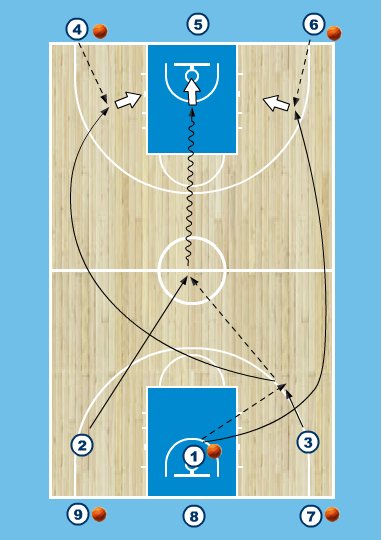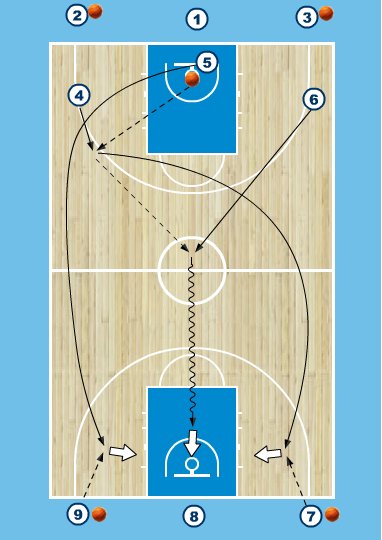Basketball drill: fastbreak / warm-up exercise - craps
Suitable for the following techniques: passing warming-up
Fastbreak / Warm-up exercise - Craps
Emphasis can be placed on different fundamental items. Passing, ball handling, transition or shooting. You can
give it a conditional character for the core of your training.
The exercise is also fairly complex, which means that the players also have to think a little during the exercise (brain training).


- The exercise starts with a plurality of 3 players.
- Even if you don't have a plural of 3, the exercise is possible, only then one player steps out each time. #1/#2/#3 start the exercise with a half weave to the center line.
- After his pass #1 becomes a flyer and after the pass from #3 he also becomes a flyer. #2 receives the ball last and dribbles midcourt for a score (lay-up).
- #3 and #1 receive the ball from #4 and #6 for the shot from outside. #5 rebounds the ball from #2, and starts the same drill along with #4 and #6.
- In this way this exercise repeats itself and a full court continuous drill is created.
Variations:
- The ballhandler (#2 in the first diagram) must finish with at least 1 change of direction (spindribble, reverse dribble, crossover, etc)
- Give the ballhandler a maximum number of dribbles so that he finishes aggressively.
- Have the 2 flyers who receive the ball stop with a jump stop / rhythm stop / or take 1 dribble and pull-up.
- Have the 2 flyers make a jab step with a countermove
- Starting with a rebound situation, you can vary with #1 / #2 / #3 in a row and throwing the ball up against the board (tipping), or have two players start at the board where one defends the outlet pass.
- The disadvantage of this is, that you have to constantly reorganize, and the continuous nature of the exercise disappears.
- Have #2 (in the first diagram) defend the ballhandler with a close-out and box out after the score or goal attempt.
- The 2 flyers make a "split the post" move, so they make a front move and cut in on the other side.
- This is a very good variation in terms of timing, as it involves three players.
Teaching points:
- Require the tempo you want from the players. Depending on the age, the exercise should reflect what you want to train. Keep in mind that the organization is quite complex, so for younger ages you will spend a lot of time on "organizing" the drill. So, wasted time, and ask yourself if you have this time.
- Make good stops, when catching the ball (flyers). Be critical on running, see that players make a stable stop, bring butt back, and jump straight up. The shot starts with the “foundation†and that is the footwork. If that is not right, it will affect all of your shot.
- Ballhandler finished hard on the basket. Re-enact the game situation! The attacker must visualize the defender. So dribble with the right hand (your body between the ball and the defender), protect the ball, also in 2T rhythm.
- Also use a situation where the ballhandler is the "front man" of the pitch, and therefore has to finish with a speed dribble: high, forward dribble, push the ball in front of you, and as few dribbles as possible (every dribble is a risk).
- Passing: Think about a good passing technique and its teaching points: Pass in front of the man, ask, make eye contact, target as a receiver, run into the ball, pass tightly, arms out, thumbs down after the pass. Also remember that players do not necessarily have to complete their 2T rhythm.
- Finish: Going hard to the board, and letting the ball “kiss†the board. The ball makes a so-called soft touch against the board. Especially with young players this is obvious, as they tend to “throw†the ball against the board when going hard. This implies that they have to rise (long stride, small stride, take a knee, stretch, the ball actually leaves your hand automatically due to the vertical movement of your body, do not bump).
- Shooting: Basics are footwork! Make a good stop, and the feet should be in the right position. Shoulder width, foot under the shot-hand slightly in front of the other, slightly through the knees (120 degrees), straight back, upper arm immediately horizontal after the catch, and forearm slightly less than 90 degrees. The forearm moves in a vertical direction first, and do not bring the ball behind your head (a common mistake among children). Look under the ball and then do the follow-through. Wrist flap and follow through!
- First train and program the technique, then focus on the speed. Note: this will not work in 1 training! Depending on the age, you can play with this, read: put the emphasis on something.








